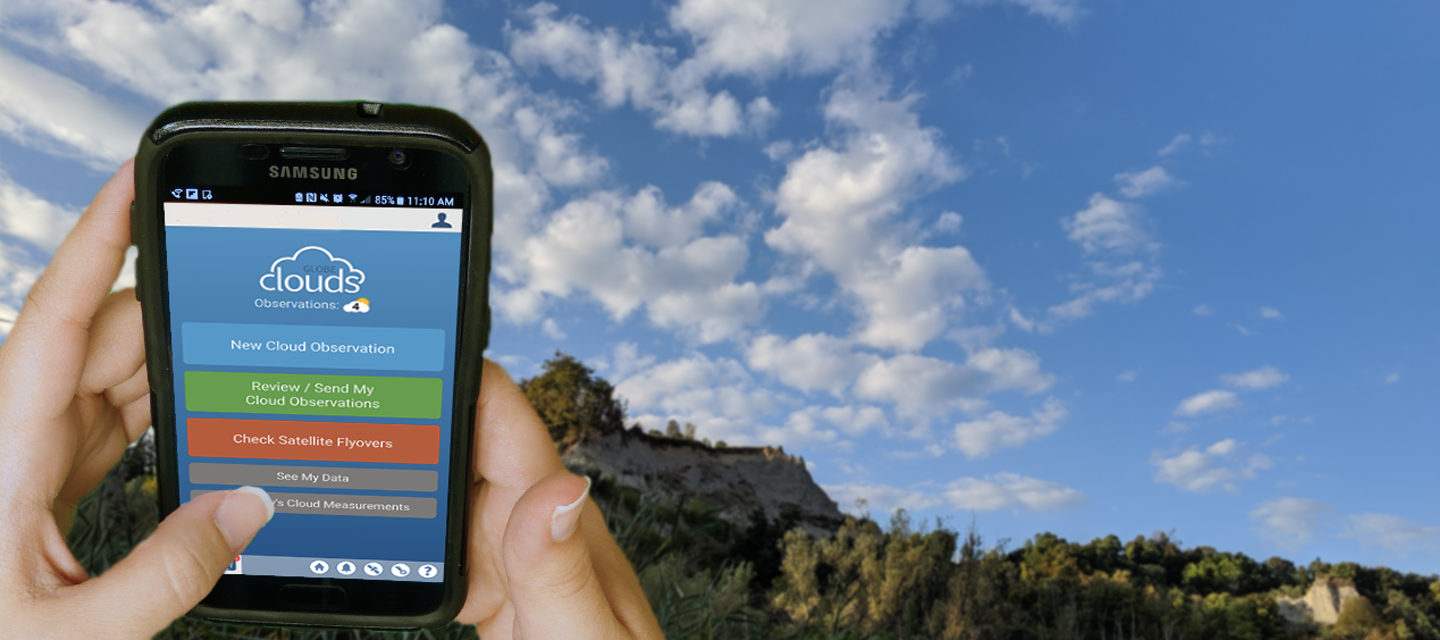Clouds Overview - GLOBE Observer
What is GLOBE Clouds?

GLOBE Clouds is an app-based tool that will help you document what you see in the sky. Once you have downloaded the GLOBE Observer app and created an account, the Clouds tool (including the Clouds Wizard if you wish to use it) will guide you through the observation process. Required data includes providing your location, reporting on overall cloud cover and surface conditions that can impact satellite observations. Optional (but very useful) data include cloud types, cloud opacity, sky conditions and visibility, then taking photos of what you see in the sky. Even a basic observation without optional elements is valuable! For more details about how to take observations, including tips and tricks, additional tutorials beyond what is in the app, and frequently asked questions about how to observe, visit the Taking Observations page. Our Resource Library includes additional activities, references, videos and book lists.
Why are my observations important?
Clouds are a major component of the Earth’s system that reflect, absorb, and scatter sunlight and infrared emissions from Earth. This affects how energy passes through the atmosphere. Different types of clouds have different effects, and the amount of cloud cover is also important. Clouds can change rapidly, so frequent observations are useful to track these changes. Such observations are able to see change over time and help with interpretation of satellite cloud data. Learn more about the science of clouds, and how NASA studies them, on the Clouds Science page.
Satellite Matching
Clouds observations matched to satellite overpasses are especially helpful. Within the app, you can check the timing of satellite flyovers for your location, and set notifications to remind you to go make an observation. Learn more about satellite matching of your observations on the Clouds Science page.
Student Research
In addition to research done by professional scientists, because GLOBE Observer is part of The GLOBE Program, which is active in thousands of schools across the world, citizen scientists are strengthening science education by providing data for student research.
Here are a few examples of student research reports related to clouds:
"The Relationship Between Cloud Cover to Temperature and Humidity," by Llyn L. Escarcha Ashanti F. Pangue, students from Batasan Hills National High School, in Quezon City, Philippines; GLOBE Teacher, Babie Noreen Padilla Clemente; submitted to GLOBE on 10 March 2020.
"Contrail Formation in Southeastern Michigan with Potential Regional and Global Impacts," by Noor Abu-Rus and Zaharaa Altwaij, students from Crestwood High School in Dearborn, Michigan, USA; GLOBE Teacher, Diana Johns; submitted to GLOBE on 09 March 2020.
"Comparison of Clouds Fixed by Palupera GLOBE Members and NASA Satellites," by Marite-Marielle Treial and Terle Tamm, students from Palupera Primary School in Palupera, Estonia; GLOBE Teacher, Arvet Silk; submitted to GLOBE on 08 March 2020.
"The Impact of Cloud Cover on Surface Temperature," by Kennedy Hardy, Peyton Pitt, and Adeline Turkington, students from Shumate Middle School in Gibraltar, Michigan, USA; GLOBE Teacher, Jeff Bouwman; submitted to GLOBE on 06 March 2020.
"A Comparison of Daily Air Temperature and Number of Observed Contrails," by Starlyn C., Omar J-F., Vanessa R., Tayqwan R., students from the Lexington School for the Deaf in East Elmhurst, New York, USA; GLOBE Teacher Jillian Anderson; submitted to GLOBE 01 June 2019.
For more research reports related to clouds, visit the GLOBE Student Research Reports page (filtered for the Clouds protocol).
GLOBE Observer Now
The following has evaluated to null or missing:
==> rootElement.selectSingleNode("/root/dynamic-element[@name='event_title']/dynamic-content") [in template "gov-globe-templates-theme_SERVLET_CONTEXT_/templates/observer/widget-templates/asset-publisher-template/observer-now-events-template-1.0.0.ftl" at line 31, column 29]
----
Tip: If the failing expression is known to legally refer to something that's sometimes null or missing, either specify a default value like myOptionalVar!myDefault, or use <#if myOptionalVar??>when-present<#else>when-missing</#if>. (These only cover the last step of the expression; to cover the whole expression, use parenthesis: (myOptionalVar.foo)!myDefault, (myOptionalVar.foo)??
----
----
FTL stack trace ("~" means nesting-related):
- Failed at: articleTitle = rootElement.selectSing... [in template "gov-globe-templates-theme_SERVLET_CONTEXT_/templates/observer/widget-templates/asset-publisher-template/observer-now-events-template-1.0.0.ftl" at line 31, column 14]
- Reached through: #include "/gov-globe-templates-theme_... [in template "10132#10165#77817366" at line 2, column 1]
----
1<#-- gov-globe-templates-theme -->
2<#include "/gov-globe-templates-theme_SERVLET_CONTEXT_/templates/observer/widget-templates/asset-publisher-template/observer-now-events-template-1.0.0.ftl" />








